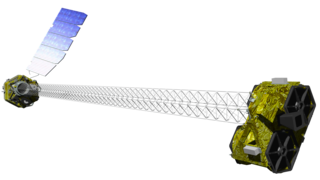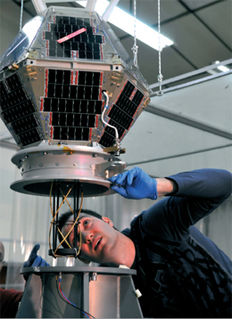
A CubeSat is a class of miniaturized satellite based around a form factor consisting of 10 cm (3.9 in) cubes. CubeSats have a mass of no more than 2 kg (4.4 lb) per unit, and often use commercial off-the-shelf (COTS) components for their electronics and structure. CubeSats are put into orbit by deployers on the International Space Station, or launched as secondary payloads on a launch vehicle. As of August 2021, more than 1,600 CubeSats have been launched.

A small satellite, miniaturized satellite, or smallsat is a satellite of low mass and size, usually under 1,200 kg (2,600 lb). While all such satellites can be referred to as "small", different classifications are used to categorize them based on mass. Satellites can be built small to reduce the large economic cost of launch vehicles and the costs associated with construction. Miniature satellites, especially in large numbers, may be more useful than fewer, larger ones for some purposes – for example, gathering of scientific data and radio relay. Technical challenges in the construction of small satellites may include the lack of sufficient power storage or of room for a propulsion system.

NuSTAR is a NASA space-based X-ray telescope that uses a conical approximation to a Wolter telescope to focus high energy X-rays from astrophysical sources, especially for nuclear spectroscopy, and operates in the range of 3 to 79 keV.

Soil Moisture Active Passive (SMAP) is a NASA environmental monitoring satellite launched on 31 January 2015. It was one of the first Earth observation satellites developed by NASA in response to the National Research Council's Decadal Survey.
Solar X-Ray Spectrometer, or SOXS, was an experimental payload launched onboard Indian geostationary satellite GSAT-2 by the Indian Space Research Organisation, ISRO. SOXS collected data about X-ray emissions from solar flares with high energy and temporal resolutions.

The Nanosat-1B Spanish satellite, designed, developed and operated by the Instituto Nacional de Técnica Aeroespacial (INTA), is a nanosatellite which weighs 22 kg. Its main mission is the communication between remote sites like the Antarctic, the Hespérides warship and Spain. The Nanosat-1B has fourteen sides, all of them covered by solar cells but the bottom one where the following antennas are installed: a medium gain Ultra high frequency (UHF) four wire antenna and two patch antennas. On the top side there are four UHF monopoles. The solar sensors and the Vectorsol experiment are located in the middle tray, being all the other equipment and experiments located inside the satellite.

Colorado Student Space Weather Experiment (CSSWE) was the sixth National Science Foundation sponsored CubeSat mission. It was built by students at the University of Colorado at Boulder with advising from professionals at the Laboratory for Atmospheric and Space Physics. The CSSWE mission was a joint effort by the University of Colorado's Department of Aerospace Engineering Sciences and Laboratory for Atmospheric and Space Physics. The mission principal investigator was Prof. Xinlin Li, and the Co-PIs are Prof. Scott Palo and Dr. Shri Kanekal. The project manager for the project was Dr. Lauren Blum, the system engineer was Dr. David Gerhardt, and the instrument scientist was Dr. Quintin Schiller.
Electron Losses and Fields Investigation (ELFIN) is a nanosatellite developed by University of California, Los Angeles (UCLA). ELFIN is a 3U+ CubeSat designed to study space weather, specifically, the loss of relativistic electrons in the radiation belts. ELFIN was a participant in the Air Force Research Lab's University Nanosatellite Program and is currently funded by NASA's Low Cost Access to Space program and the National Science Foundation.

BioSentinel is a planned low-cost CubeSat spacecraft on a astrobiology mission that will use budding yeast to detect, measure, and compare the impact of deep space radiation on DNA repair over long time beyond low Earth orbit.

Lunar IceCube is a planned NASA nanosatellite orbiter mission to prospect, locate, and estimate amount and composition of water ice deposits on the Moon for future exploitation by robots or humans. It will fly as a secondary payload mission on Artemis 1, the first flight of the Space Launch System (SLS), planned to launch in 2022.
CubeSat for Solar Particles (CuSP) is a planned nanosatellite spacecraft that will study the dynamic particles and magnetic fields that stream from the Sun.

Lunar Polar Hydrogen Mapper, or LunaH-Map, is one of 10 CubeSats planned to be launched with Artemis 1 in 2022. Along with Lunar IceCube and LunIR, LunaH-Map will help investigate the possible presence of water-ice on the Moon. Arizona State University began development of LunaH-Map after being awarded a contract by NASA in early 2015. The development team consists of about 20 professionals and students led by Craig Hardgrove, the principal investigator.
ArgoMoon is a nanosatellite that will fly on NASA's Artemis 1 mission into a heliocentric orbit in cislunar space on the maiden flight of the Space Launch System (SLS) and the Orion spacecraft, in 2022. The satellite has the dimensions of a shoe box ; in CubeSat terms, it is a 6U.

Irvine CubeSat STEM Program (ICSP) is a joint educational endeavor to teach, train and inspire the next generation of STEM professionals. ICSP involves students from six high schools from Irvine, California, and its main objective is to assemble, test, and launch a CubeSat into low Earth orbit.

ASTERIA was a miniaturized space telescope technology demonstration and opportunistic science mission to conduct astrophysical measurements using a CubeSat. It was designed in collaboration between the Massachusetts Institute of Technology (MIT) and NASA's Jet Propulsion Laboratory. ASTERIA was the first JPL-built CubeSat to have been successfully operated in space. Originally envisioned as a project for training early career scientists and engineers, ASTERIA's technical goal was to achieve arcsecond-level line-of-sight pointing error and highly stable focal plane temperature control. These technologies are important for precision photometry, i.e., the measurement of stellar brightness over time. Precision photometry, in turn, provides a way to study stellar activity, transiting exoplanets, and other astrophysical phenomena.
EQUULEUS is a nanosatellite of the 6U CubeSat format that will measure the distribution of plasma that surrounds the Earth (plasmasphere) to help scientists understand the radiation environment in that region. It will also demonstrate low-thrust trajectory control techniques, such as multiple lunar flybys, within the Earth-Moon region using water steam as propellant. The spacecraft was designed and developed jointly by the Japan Aerospace Exploration Agency (JAXA) and the University of Tokyo.

IceCube, also known as Earth-1, was a 3U CubeSat satellite funded and developed by NASA. Its goal was to demonstrate and map ice clouds through the use of its 883 GHz radiometer.

Cosmic X-ray Background Nanosatellite-2 was a satellite and mission developed by the Morehead State University to follow up on the CXBN mission launched in 2012. It was an improved version of the previous spacecraft and it increased the precision of measurements of the cosmic X-ray background in the 30-50 keV range and helped to improve understanding of the early universe.











